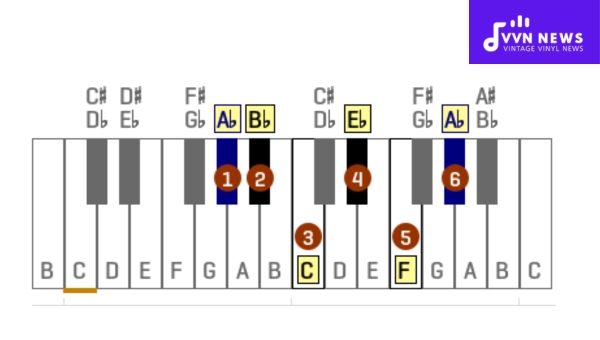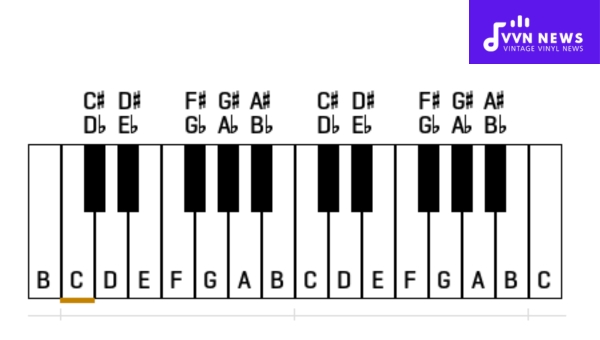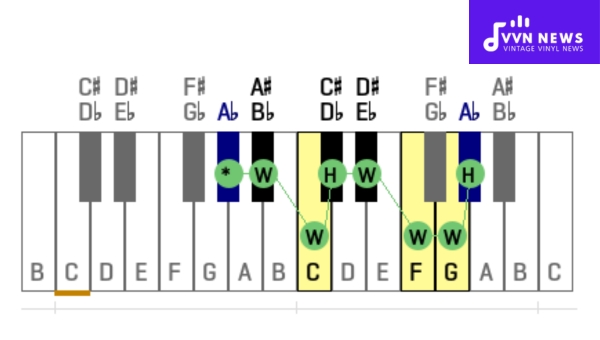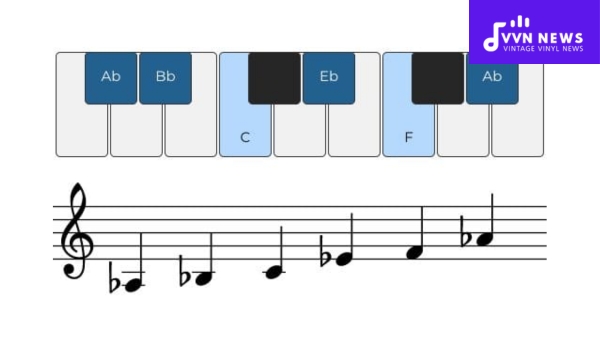In the world of music, numerous scales give songs and melodies their unique sound.
One such scale that has carved out its niche in the auditory universe is the A flat major pentatonic scale.
This scale may sound complex if you’re not acquainted with music theory but believe it or not, its beauty lies in its simplicity.
Often featured in a wide range of music genres from blues to pop, understanding the A flat major pentatonic scale can open up a wealth of creative potential.
If you’ve ever dabbled with an instrument or attempted to construct a melody, you’ll already know that scales aren’t just arbitrary sequences—they are building blocks for songwriters, underpinning structure and feeling in every tune.
What describes the A Flat Major Pentatonic Scale?
A Flat Major Pentatonic Scale is an important part of music theory with a simple and clean symmetry.
Predominantly used in jazz, blues, and rock music genres, its resonance harmonizes well with a vast array of chord progressions.
This scale consists of five notes: A flat (Ab), B flat (Bb), C, E flat (Eb), and F. The symphony created by these particular notes is both soothing and compelling.
Unique from other scales in its minimalism, the absence of half steps or semitones aids in avoiding discordance or the feeling of ‘wrong’ notes.
Consequently vivifying a melodic complexity that’s easy on the ears yet rich in expressivity.
How do you formulate the A Flat Major Pentatonic Scale?
Crafting the A Flat Major Pentatonic Scale centers around an elegantly simple formula. Imagine standing before your instrument, poised to craft something melodious.

The pentatonic scale is akin to choosing the choicest ingredients for a gourmet recipe—the finest five notes that set a tranquil ambiance.
Step into musical alchemy with these steps:
- Begin at A♭, your root note.
- Move up to the second scale degree, which is B♭.
- Leap over the third and land on C, your third scale degree.
- Elevate to E♭, which is the fourth degree of the major pentatonic.
- Conclude with F, completing the fifth degree.
This exquisite selection omits half and whole steps that typically define major scales, leaving you with an uncluttered sonic palette – perfect for weaving serenity into your music.
Also Read: G Major Pentatonic Scale [Decipher The Most Popular Music Scale]
What are the five versions of the A Flat Major Pentatonic Scale?
The A Flat Major Pentatonic Scale is a versatile and melodious scale that can be played in different positions on the fretboard.
Regardless of the instrument you play, mastering these shapes will allow you to navigate the scale with ease across the entire range of your instrument.
Let’s break down each of these five distinct shapes:
Shape One: The Root Position
The root position starts on the ‘A flat’ note, which serves as our tonal home base.
This shape is often the first that musicians learn. It typically spans from the root note up to its octave.
- Start on ‘A♭’ (Lowest string)
- Proceed to ‘C’
- Move to ‘D♭’
- Then ‘E♭’
- Follow with ‘F’
- Conclude with ‘A♭’ (One octave higher)
Shape Two: The Second Position
In second position, you shift slightly up from where the root position ends, initiating your sequence from what was previously your second note in shape one.
- Begin on ‘C’
- Continue to ‘D♭’
- Ascend to ‘E♭’
- Onward to ‘F’
- Up next is ‘A♭’
- Wrap it up at ‘C’ (Higher octave)
Shape Three: The Third Position
The third position extends even further up the neck. You’ll start playing this shape from what was previously the third note, creating a whole new pattern but still within our scale.
- Open with ‘D♭’
- Up next, find ‘E♭’
- Climb to ‘F’
- Move ahead to ‘A♭’
- Slide into ‘C’
- Finish on ‘D♭’ (Next octave)
Shape Four: The Fourth Position
As we advance our journey across the fretboard, shape four has us commence on what was earlier our fourth note. It continues following this logical pattern progression throughout.
- Kick off with ‘E♭’
- Upward to ‘F’
- Shift toward ‘A♭’
- Progressing to ‘C’
- Advance onwards ‘D♭’
- Complete this run at ‘E♭’ (One more octave up)
Shape Five: The Fifth and Final Position
Exploring all regions possible, we reach our fifth and final form. This begins where shape four left off carrying forward our exploration into higher tones and embellishments.
Starting Point:
- Initiate with an ‘F‘.
- Ascend directly into an ‘A flat’.
- Continue towards ‘C‘.
- Venture forth arriving at ‘D flat’.
- Approach nearer towards an ‘E flat’.
- Culminate magnificently at an elevated ‘F‘.
Utilizing backing tracks aligning with A Flat Major could significantly bolster musicianship as one transitions fluidly between these pentatonic frameworks during improvisation or composition sessions.
By familiarizing oneself with each distinct shape within both lower and upper register realms, seamlessly melding them becomes almost second nature—a priceless skill for jam sessions or solo performances alike.
Also Read: Explore The G Flat Major Pentatonic Scale [For Piano & Guitar]
What’s the correlation between Major and Minor Pentatonic Scales?
The relationship between the relative major and minor pentatonic scales is as intriguing as it is musical.

Each major pentatonic scale pairs with a minor pentatonic scale that shares the same key signature, meaning they consist of the same notes but start on different roots.
To find the relative minor of an A flat major pentatonic scale, count down three semitones (or move down three frets on a guitar), landing on F. Thus, the F minor pentatonic scale becomes its counterpart.
This parallel means when you’ve learned one pattern, a different mode can be played without needing to relearn new notes—just shift your starting point.
These dual-scale connections greatly expand your repertoire without muddling your practice with extensive note memorization.
How Effective Are Backing Tracks for A Flat Major Pentatonic Scale Practice?
Utilizing backing tracks tailored to the A Flat Major Pentatonic Scale can significantly enhance your practice sessions.
Not only do they provide a musical context that enriches learning, but they also bring several benefits:
Structured Practice Sessions
When you incorporate backing tracks into your routine, you create structure.
This boundary helps you to focus on the scale patterns and phrases, thereby establishing muscle memory and internalizing its tonal quality.
Timing and Rhythm Improvement
Playing alongside a rhythmic accompaniment ensures that your timing remains consistent.
It’s essential to develop a solid sense of rhythm and playing with backing tracks acts as a virtual metronome.
Ear Training
Exposure to the harmonic groundwork set by backing tracks aids in honing your ear.
As you play, you’ll learn to identify how the A Flat Major Pentatonic notes interact with various chord progressions—a valuable skill for improvisation.
Creativity Boost
As a creative canvas, these tracks encourage improvisation within the familiar structural confines of the pentatonic scale.
You get the opportunity to experiment with phrasing, articulation, and dynamics in a way solo practice doesn’t always allow.
Performance Readiness
Practicing with backing tracks simulates actual performance conditions.
You become acclimatized to playing in an ensemble setting which builds confidence and stage presence—crucial aspects for live performances.
Blending backing tracks with your practice of the A Flat Major Pentatonic is indeed highly effective.
They are not just playful aides but rather transformative tools forging competence and creative prowess in musicianship.
Also Read: E Major Pentatonic Scale [Express Emotion Through Music]
Songs Featuring the A Flat Major Pentatonic Scale
The A flat major pentatonic scale often serves as a sonic backdrop for a myriad of songs across various genres, gracing melodies with its distinct character.

Its rich tonal texture enhances several popular tracks you might recognize. Here’s a look at five notable songs that incorporate this scale:
“Sweet Home Alabama” by Lynyrd Skynyrd
While not immediately obvious, the guitar solo sections of “Sweet Home Alabama” weave in parts that draw from the pentatonic configuration, including arrays from the A flat major pentatonic family.
It underpins the iconic Southern Rock feel with a melodic richness that is instantly relatable.
“My Girl” by The Temptations
This Motown classic consistently dips into the pentatonic well. The smooth flow of the A flat major pentatonic scale is identifiable in key segments of its serene and soulful melody line, making it integral to this timeless hit’s charm and easy-listening nature.
“Thriller” by Michael Jackson
The King of Pop’s famous track “Thriller,” known for its quintessential ’80s vibe, subtly embeds elements from this scale throughout its bass riffs and vocal harmonies, showcasing how versatile and adaptive the A flat major pentatonic can be in pop music composition.
“I’m Yours” by Jason Mraz
Jason Mraz’s light-hearted strums on his ukulele within “I’m Yours” contain traces of the A flat major pentatonic that contribute to this song’s relaxing and uplifting ambiance—proving simplified scales can generate profound auditory effects.
“Purple Haze” by Jimi Hendrix
A bit more unexpected, Hendrix’s “Purple Haze” also utilizes principles ingrained within our focus scale.
The intro riff takes advantage of these tones to produce an otherworldly and psychedelic effect that forever altered rock guitar playing.
These songs effectively showcase the versatility and universality of the A flat major pentatonic scale.
In varying degrees, each piece pulls its essence into service for unique creative expressions that have left their mark on music history.
Also Read: D Flat Major Pentatonic Scale [Master Its Joyful Tones]
FAQs About The A Flat Major Pentatonic Scale
What notes make up the A Flat Major Pentatonic Scale?
The A Flat Major Pentatonic Scale is comprised of the notes A♭, B♭, C, E♭, and F.
Can I use the A Flat Major Pentatonic Scale over any chord progression?
This scale works best over chords that imply an A Flat major tonality; it’s not as versatile over other progressions.
Is the A Flat Major Pentatonic Scale suitable for beginners?
Yes, due to its limited note selection and pleasant sound, it’s ideal for beginners looking to improvise or compose.
What is the relative minor of the A Flat Major Pentatonic Scale?
The relative minor of A Flat Major Pentatonic is F Minor Pentatonic; they share the same notes but start on different root notes.
Are there any common patterns or shapes to learn this scale on guitar?
Yes, there are standard box patterns you can learn to navigate this scale efficiently on the fretboard.
Conclusion
In summary, A Flat Major Pentatonic Scale presents a melodic opportunity for musicians seeking simplicity with a sweet sound.
Whether you’re composing or improvising, this scale serves as a trusty canvas.
Remember to practice using different patterns and contexts, and don’t forget the emotional tone it can lend to various musical genres.
Dive into this scale with backing tracks or apply it in your favorite songs to fully explore its versatility.








